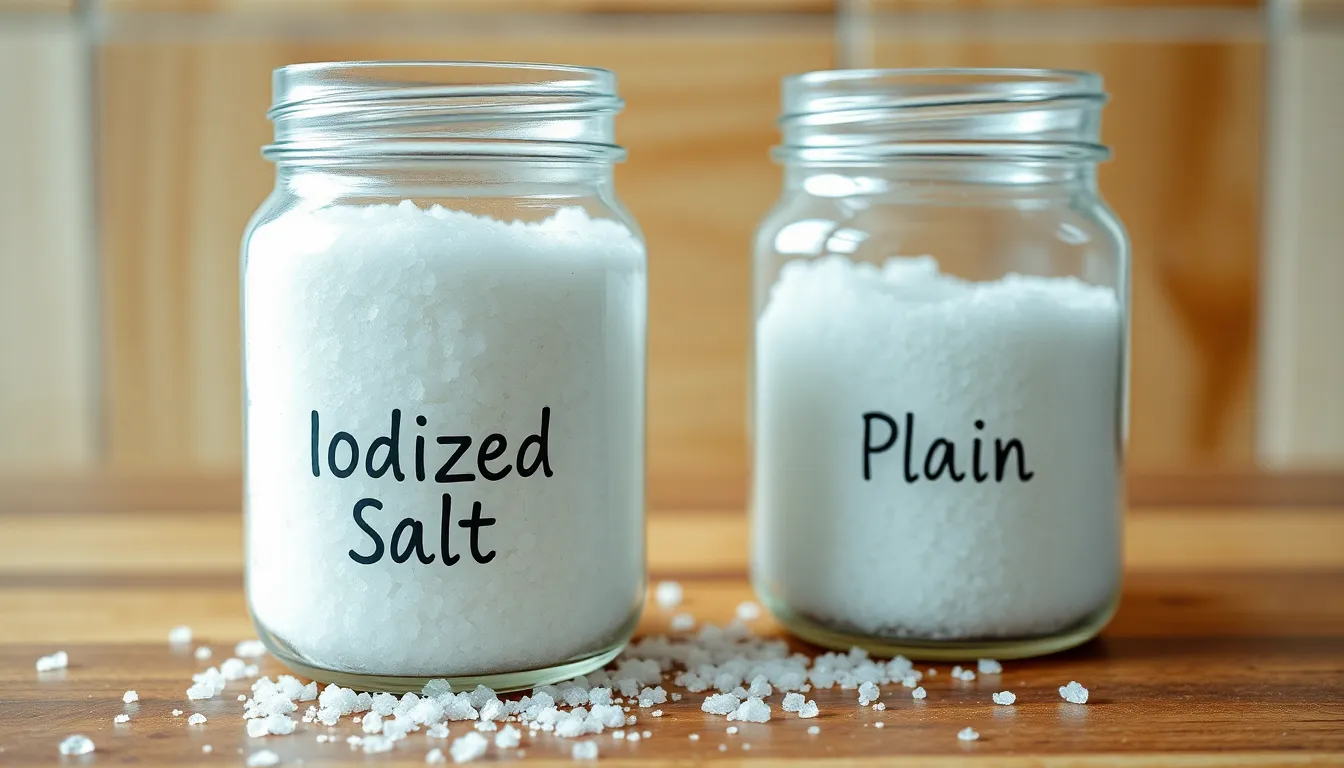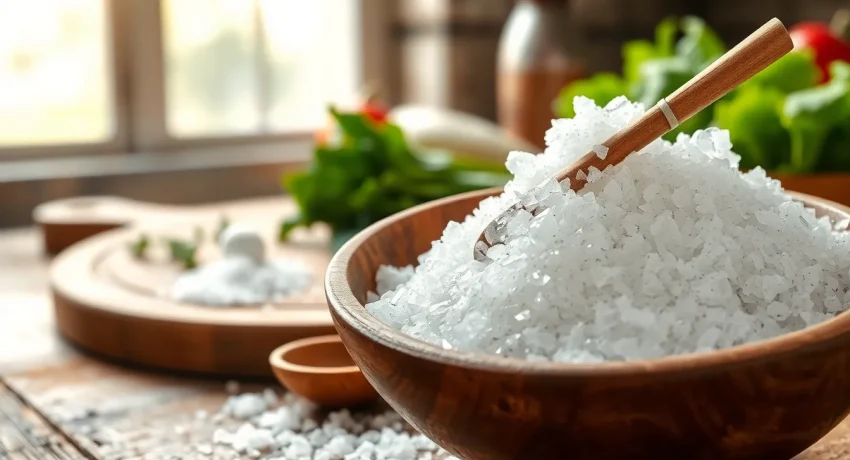Table of Contents
ToggleSalt is a staple in kitchens around the world, but not all salt is created equal. Iodized salt and plain salt serve the same basic purpose in cooking and seasoning, yet they differ significantly in nutritional value and health benefits. Understanding these differences can help consumers make informed choices for their diets.
Iodized salt is fortified with iodine, an essential nutrient that plays a crucial role in thyroid function and overall health. In contrast, plain salt lacks this important mineral, which can lead to deficiencies in areas where dietary iodine is low. As people become more health-conscious, the debate over iodized salt versus plain salt continues to gain traction, prompting many to reconsider what they sprinkle on their meals.
Overview of Salt Types
Salt types vary primarily in their mineral content and processing methods. The two main types discussed are iodized salt and plain salt.
Iodized Salt
Iodized salt contains added iodine, a vital nutrient for thyroid health. It helps prevent iodine deficiency disorders, which can lead to health issues like goiter and cognitive impairments. Most health organizations recommend iodized salt as a dietary staple, especially in regions where iodine levels are low.
Plain Salt
Plain salt, or non-iodized salt, lacks added iodine. It is primarily composed of sodium chloride, and commonly used types include sea salt, table salt, and kosher salt. While plain salt serves well for flavor enhancement in cooking, it does not provide the essential nutrients found in iodized varieties.
Health Implications
Health implications of salt type consumption are significant. Consuming iodized salt can prevent deficiency-related diseases, especially in populations with limited iodine sources. Regular intake of plain salt may pose risks if dietary iodine is also low, particularly in areas with known deficiencies.
Culinary Uses
Culinary uses differ between salt types. Iodized salt often blends seamlessly into everyday meals, making it ideal for seasoning dishes. Plain salt, particularly varieties like sea salt, may offer varied texture and flavor profiles, appealing to gourmet cooking and specific dietary preferences.
Nutritional Differences

Iodized salt and plain salt differ significantly in nutritional content, particularly concerning iodine levels and additional nutrients. Understanding these differences is crucial for making informed dietary choices.
Iodine Content
Iodized salt contains added iodine, which is essential for thyroid hormone production and regulation. One teaspoon of iodized salt typically provides around 45 micrograms of iodine, meeting approximately 30% of the recommended daily intake for adults. In contrast, plain salt lacks iodine, posing risks in areas with limited iodine-rich food sources. Iodine deficiency can lead to serious health issues, including goiter and cognitive impairments, highlighting the importance of iodized salt in diets where iodine is scarce.
Other Nutrients
Iodized salt remains primarily sodium chloride, much like plain salt. However, some types of iodized salt may contain trace minerals, depending on their source. Plain salt varieties, such as sea salt and kosher salt, can also offer trace minerals including magnesium, calcium, and potassium. These minerals contribute to their unique flavors and textures, enhancing culinary applications. While both salt types provide sodium, iodized salt’s added iodine makes it a vital choice for preventing deficiency-related health problems, particularly in vulnerable populations.
Health Implications
Iodized salt and plain salt each present distinct health implications worth considering for overall nutrition and wellness.
Benefits of Iodized Salt
Iodized salt serves as a primary source of dietary iodine, essential for maintaining healthy thyroid function. With approximately 45 micrograms of iodine per teaspoon, it fulfills about 30% of the recommended daily intake for adults. Iodine plays a critical role in hormone production, regulating metabolism, and supporting cognitive development. In populations where dietary iodine is low, consuming iodized salt significantly reduces the risk of goiter and cognitive impairments. Iodized salt also supports prenatal health, as sufficient iodine is crucial for fetal brain development, making it a necessary dietary staple, particularly in regions lacking iodine-rich foods.
Risks of Plain Salt
Plain salt, comprising various types like sea salt and table salt, primarily contains sodium chloride with no added iodine. In areas where iodine intake is insufficient, relying solely on plain salt can lead to iodine deficiency. Potential health risks include thyroid disorders, hypothyroidism, and developmental issues in children. High sodium intake, common with excessive plain salt consumption, may also contribute to hypertension and cardiovascular problems. The lack of iodine in plain salt necessitates alternative iodine sources, such as dairy, fish, or supplements, to ensure overall health and adequate nutrient intake.
Culinary Uses
Iodized salt and plain salt serve distinct culinary roles. Both contribute to flavor enhancement, yet their applications can differ based on additional properties.
Flavor Differences
Iodized salt has a slightly metallic taste due to the added iodine, which may influence its flavor profile in dishes. Plain salt, particularly varieties like sea salt or kosher salt, offers a purer taste and varies in texture. Fine-textured salts dissolve quickly, while coarse salts provide a burst of flavor, enhancing dishes differently. Both types work well in savory recipes, but for gourmet applications, many chefs prefer plain salt for its nuanced taste.
Cooking Considerations
Iodized salt functions well for general cooking and baking, due to its fine granule size, ensuring even distribution of flavor. Recipes requiring precise measurements benefit from the consistent iodine content. Plain salt, although not rich in iodine, allows for creative uses, such as finishing dishes or seasoning meats, enhancing the overall dish with its varied textures. For pickling and brining, the choice between iodized and plain salt may depend on flavor preference, as plain salt may yield a more authentic taste.
Environmental Impact
Iodized salt and plain salt differ in their environmental footprints due to their production and sourcing processes. Iodized salt typically undergoes more processing, which may include the addition of iodine and other anti-caking agents. This processing can result in increased energy consumption and generates waste. In contrast, plain salt, especially when harvested from natural sources like the ocean or salt mines, may have a smaller environmental impact, depending on the extraction methods used.
Salt harvesting from seawater involves evaporation techniques that require minimal energy, while mining salt can have ecological consequences, including habitat disruption. Sustainable practices in salt production aim to minimize environmental degradation. Sea salt production can utilize renewable energy sources and may even contribute positively to local ecosystems if managed correctly.
In regions where iodized salt is prevalent, responsibility exists to ensure sustainable iodine sources. Iodine often comes from natural deposits like kelp or seaweed, though synthetic options are available. The emphasis on sustainable iodine sourcing is essential in maintaining ecological balance while addressing nutritional needs.
The choice between iodized and plain salt may also reflect consumer awareness of environmental issues. Individuals prioritizing sustainability might gravitate toward plain salt derived from eco-friendly practices, while others may focus on health benefits from iodine fortification. Considerations regarding packaging and transportation emissions further influence environmental impact assessments for both salt types.
Understanding these environmental factors allows consumers to make informed choices when selecting salt varieties. Attention to salt production methods can enhance efforts to promote safe and sustainable sources in the food supply chain.
Choosing between iodized salt and plain salt involves more than just flavor preferences. Iodized salt plays a crucial role in preventing iodine deficiency and supporting overall health. For those living in areas with limited iodine intake it’s a vital dietary staple. On the other hand plain salt offers unique textures and flavors that appeal to culinary enthusiasts.
Understanding the nutritional differences and health implications can guide consumers in making informed choices. Additionally considering the environmental impact of salt production can enhance decision-making. Ultimately it’s about balancing health needs with culinary desires while ensuring sustainable practices in salt sourcing.




